Manuel Pinto da Fonseca
| Manuel Pinto da Fonseca | |
|---|---|
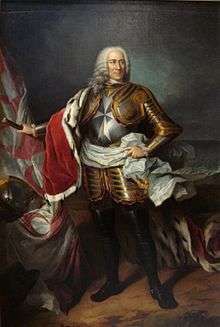 Portrait by Pierre Bernard (1704-1777) | |
| Grand Master of the Order of Saint John | |
|
In office 18 January 1741 – 24 January 1773 | |
| Monarch | King Charles V (until 1753) |
| Preceded by | Ramon Despuig |
| Succeeded by | Francisco Ximenes de Texada |
| Personal details | |
| Born |
24 May 1681 Lamego, Kingdom of Portugal |
| Died |
23 January 1773 (aged 91) Valletta, Malta |
| Resting place | St. John's Co-Cathedral |
| Nationality | Portuguese |
| Relations | Rosenda Paulichi |
| Children | José António Pinto da Fonseca e Vilhena |
| Military service | |
| Allegiance |
|
Manuel Pinto da Fonseca (24 May 1681 – 23 January 1773)[1] was the 68th Prince and Grand Master of the Sovereign Military Order of Malta from 1741 until his death. He was a Portuguese nobleman, the son of Miguel Álvaro Pinto da Fonseca, Alcaide-Mór de Ranhados, and his wife, Ana Pinto Teixeira.
Biography
Before his election as Prince and Grand Master on 18 January 1741,[2] Pinto da Fonseca was a knight of the Langue of Portugal.[3] He gave his name to the then town of Qormi and accorded it the status of a city as "Città Pinto".[4]
In 1749, one of his bodyguards, Giuseppe Cohen, refused to join a plot led by Pasha Mustafa to stage a Muslim slave revolt; this refusal led to the exposure and suppression of the revolt, which afterward was celebrated each 29 June, the anniversary.[5] He lived an envious life to noble families in Malta, which was greatly resented by some that even awaited his long reign to end by his death.[6] He gained a bad reputation for creating large debts for the treasury of the Order, leading to bankruptcy.[7] In 1756, he has built the first printing press in Malta at the magistral palace of the Grand Master, known as la stamperia del Palazzo.[8][3][9] He had expelled the Jesuits from Malta,[10] on 28 April 1768,[11][12] in line with similar acts taken in his homeland Portugal and its Empire, in France, and the Spanish Empire.[13][14]
After the expulsion of the Jesuit Order, Pinto appropriated all the revenue accruing from its property on the island with the aim of establishing a Pubblica Università di Studi Generali. The decree constituting the University, now the University of Malta was signed by Pinto on 22 November 1769,[15][16] having been authorised to do so by the Papal brief,[13] Sedula Romani Pontificis, received on 20 October 1769. By 22 November of that year, the Grandmaster signed a bando establishing the University.[17]
As Grand Master, Pinto da Fonseca completed construction of the Auberge de Castille[18] (still one of the most important buildings in the Maltese capital city, Valletta[19]); his bust and arms adorn its façade.[18] Today this building houses the Office of the Prime Minister.[20]
During his reign, in 1764, Pinto da Fonseca negotiated with King Frederick II ("Frederick the Great") of Prussia a reunification of the Protestant Bailiwick of Brandenburg with the Order of Malta, but as Pope Clement XIII would not allow admission into a Roman Catholic organization of men he viewed as heretics the agreement came to naught.[21] Pinto da Fonseca made substantial donations to the Conventual Church, and among the most notable mementoes are two large and heavy bells cast by the Master Founder of the Order of Saint John, Aloisio Bouchut, in 1747 and 1748; they still hang in the belfries of what is now the Co-Cathedral. These bells were made by melting two basilisks that were left by the Ottomans after the Great Siege of 1565.
Pinto built nineteen storehouses at the Marina, which still bear his name,[22] and built several other buildings and structures.[23] When he died, his body was laid in a neoclassic monument with his mosaic portrait.[24][25]
He was a friend of Cagliostro. The coat of arms of the Pinto portrays five red crescents, to symbolising that the Pinto de Fonseca family won five battles with the Ottomans.[26]
The city of Qormi adopted these arms, with the tinctures reversed, for its own coat of arms and flag.[27] He had an illegitimate son by one Rosenda Paulichi, daughter of Alberigo Paulichi and Patronilla Ramuzetta, named José António Pinto da Fonseca e Vilhena, who married his first cousin Maria Inácia Pinto da Fonseca de Sousa Teixeira e Vilhena, illegitimate daughter of Francisco Vaz Pinto (his father's brother) by one Clara Cerqueira.
Pinto died on 23 January 1773, aged 91.[28] A statue of Pinto is found in Floriana.[29]
Gallery
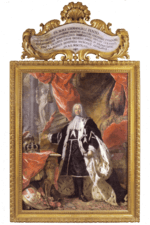 Portrait by Antoine de Favray, now in the museum of St. John's Co-Cathedral
Portrait by Antoine de Favray, now in the museum of St. John's Co-Cathedral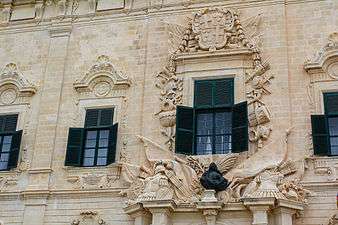 Part of the façade of Auberge de Castille (1741–45), showing Pinto's bust and coat of arms
Part of the façade of Auberge de Castille (1741–45), showing Pinto's bust and coat of arms 30 tarì coin minted in 1757
30 tarì coin minted in 1757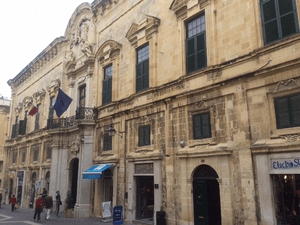 The Castellania (1757–60), built during Pinto's magistracy
The Castellania (1757–60), built during Pinto's magistracy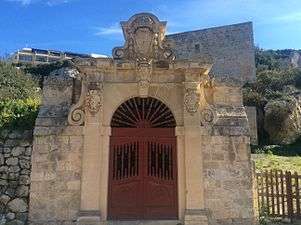 Mistra Gate (1760), containing Pinto's coat of arms
Mistra Gate (1760), containing Pinto's coat of arms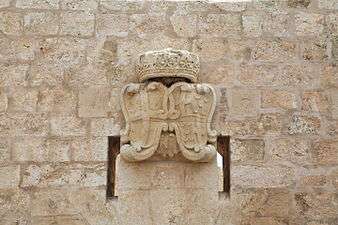 Coat of arms of Pinto and the Order on Mistra Battery (c. 1761)
Coat of arms of Pinto and the Order on Mistra Battery (c. 1761)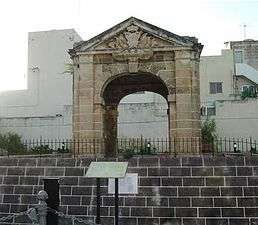 Pinto's Loggia in Qormi (1772)
Pinto's Loggia in Qormi (1772)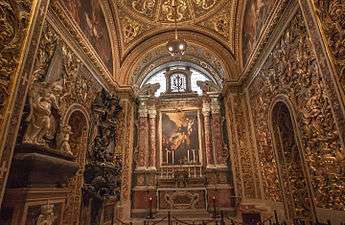 Chapel of the Langue of Castile, Leon and Portugal in St. John's Co-Cathedral, with Pinto's funerary monument visible on the left
Chapel of the Langue of Castile, Leon and Portugal in St. John's Co-Cathedral, with Pinto's funerary monument visible on the left Flag of Qormi, containing the five crescents from Pinto's coat of arms
Flag of Qormi, containing the five crescents from Pinto's coat of arms
Further reading
- Salles, Félix de (1889). Annales de l'Ordre de Malte, ou, Des Hospitaliers de Saint-Jean-de Jerusalem, chevaliers de Rhodes et de Malte, depuis son origine jusqu'à nos' jours, du Grand Prieuré de Bohême-Autriche et du Service de santé volontaire avec les listes officielles des chevaliers-profès et de justice, des chevaliers d'honneur, etc (in French). Vienne, France: Imprimerie St. Norbert. pp. 192–195. OCLC 458895934.
References
- ↑ https://www.google.com/culturalinstitute/beta/entity/m0gsxdz?categoryid=historical-figure
- ↑ Cutajar, Tony C. (2011). Mewt Lil Pinto! (in Maltese). Lulu. p. 22. ISBN 9781447841791.
- 1 2 Seddall, Henry (1870). "Emanuel Pinto". Malta: Past and Present. Chapman and Hall. p. 146.
- ↑ Cassar Pullicino, Joseph (October–December 1949). "The Order of St. John in Maltese folk-memory" (PDF). Scientia. 15 (4): 162. Archived from the original (PDF) on 17 April 2016.
- ↑ Denaro, Victor F. (1958). "Houses in Merchants Street, Valletta" (PDF). Melita Historica. 2 (3): 161–164. Archived from the original (PDF) on 4 March 2016.
- ↑ Ganado, Albert (2001). Palace of the Grand Masters in Valletta. Fondazzjoni Patrimonju Malti. p. 76. ISBN 9789993210122.
- ↑ A reign of austerity
- ↑ Mifsud Bonnici, Carmelo (August 1936). "Fr. Emanuel Pinto de Fonseca" (PDF). Malta Letteraria. 11 (8): 227.
- ↑ Lectures on the British constitution and on the government of Malta. p. 216.
- ↑ Denaro, Victor F. (1961). "More houses in Valletta" (PDF). Melita Historica. 3 (2): 3. Archived from the original (PDF) on 23 March 2016.
- ↑ Vassallo, C. (1940). "Condici e Manuscritti della Pubblica Biblioteca di Malta (continuazione e fine)" (PDF). Archivio Storico di Malta (ASM). 11 (1–2): 278. Archived from the original (PDF) on 16 April 2016.
- ↑ p. 50
- 1 2 Rudolf, Uwe Jens; Berg, Warren G. (2010). Historical Dictionary of Malta. Scarecrow Press. p. 136. ISBN 9780810873902.
- ↑ Cassar, Carmel. Megan Armstrong, Corkery, James, Alison Fleming, Thomas SJ Prieto Worcester and Henry Andrés Ignacio Shea, eds. The Cambridge Encyclopedia of the Jesuits. Cambridge University Press. pp. 496–498. ISBN 9781108508506.
- ↑ Mifsud Bonnici, Carmelo (August 1936). "Fr. Emanuel Pinto de Fonseca" (PDF). Malta Letteraria. 11 (8): 230.
- ↑ pp. 20-21
- ↑ Gozo Observer. Issue 22. June 2011. p. 3.
- 1 2 "Auberge de Castille et Leon" (PDF). National Inventory of the Cultural Property of the Maltese Islands. 28 December 2012. Archived from the original (PDF) on 4 March 2016.
- ↑ Ellul, Michael (1982). "Art and architecture in early nineteenth century Malta" (PDF). Proceedings of History Week: 3. Archived from the original (PDF) on 3 April 2016.
- ↑ "Deputat tal-PN tallega li hemm 'direct link' bejn Kastilja u l-MEPA". iNews Malta (in Maltese). 16 June 2016. Archived from the original on 21 June 2016.
- ↑ Robert M. Clark, Jr., The Evangelical Knights of Saint John: A History of the Bailiwick of Brandenburg of the Knightly Order of St. John of the Hospital at Jerusalem, Known as the Johanniter Order; Dallas, Texas: 2003; pages 18-25. Guy Stair Sainty, The Orders of Saint John: The History, Structure, Membership and Modern Role of the Five Hospitaller Orders of Saint John of Jerusalem; New York: The American Society of the Most Venerable Order of the Hospital of Saint John in Jerusalem, 1991; pages 86, 89-90.
- ↑ p. 146.
- ↑ Thake, Conrad Gerald (Spring 1996). "The Architectural legacy of Grand Master Pinto". Treasures of Malta. 2 (2): 39–43.
- ↑ Cutajar, Dominic (1999). "History and Works of art of St. John's Church Valletta - Malta" (3 ed.). M. J. Publications. p. 64. ISBN 978-9990990003. Archived from the original on 1 July 2017.
- ↑ Riland Bedford, William Kirkpatrick (1905). Malta and the Knights Hospitallers. Seeley and co., Limited. p. 34. OCLC 15910350. Archived from the original on 28 October 2008.
- ↑ de Giorgio, Cynthia (2003). The image of triumph and the Knights of Malta. Printed by Printex Ltd. p. 47. ISBN 9789993202783. OCLC 54846760.
- ↑ Cassar Pullicino, Joseph (October–December 1949). "The Order of St. John in Maltese folk-memory" (PDF). Scientia. 15 (4): 168. Archived from the original (PDF) on 17 April 2016.
- ↑ Denaro, Victor F. (1961). "More houses in Valletta" (PDF). Melita Historica. 3 (2): 4. Archived from the original (PDF) on 23 March 2016.
- ↑ Bugeja, Joe (1 March 2015). Origins and history of Argotti Gardens. Times of Malta. Retrieved 29 June 2016.
External links
| Wikimedia Commons has media related to Manuel Pinto de Fonseca (GM 68). |
| Preceded by Ramon Despuig |
Grand Master of the Knights Hospitaller 1741–1773 |
Succeeded by Francisco Ximenes de Texada |